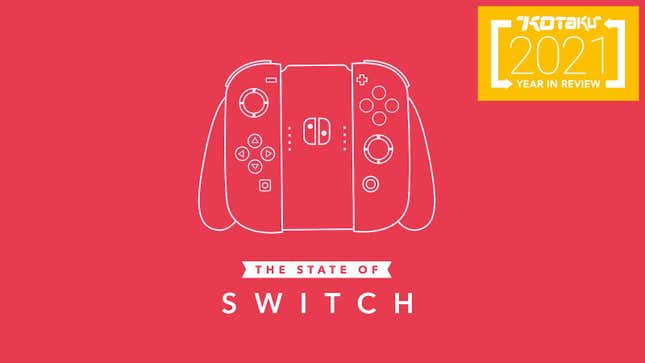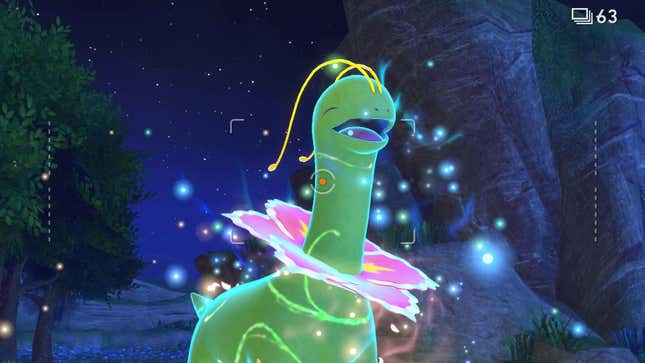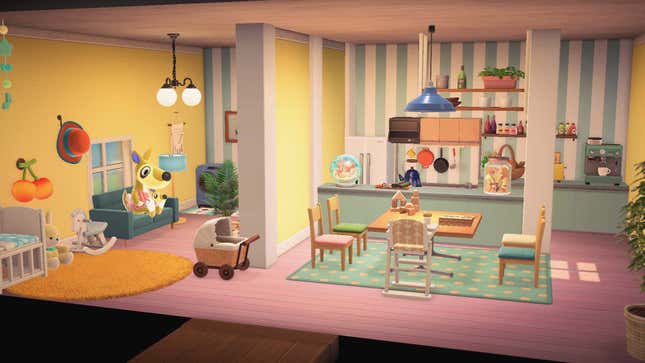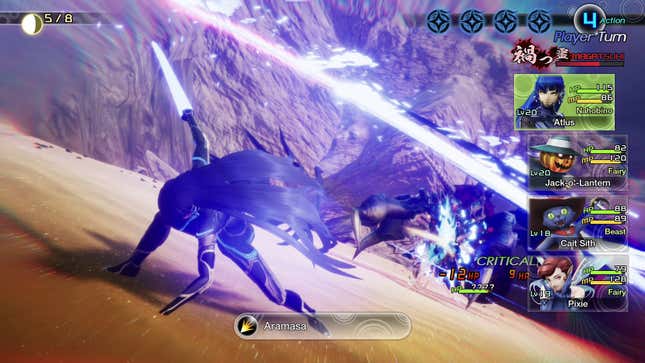
The Nintendo Switch had a pretty odd 2021, all things considered. This has been a bit of a slow year, and it is no wonder why. Developers were thrown into panic, as most of us were, by 2020’s covid-19 outbreak. While this did slow things down in 2020, a lot of games released that year were already mostly complete when stay-at-home orders came down, which led to a relatively normal first half of the year (in terms of game releases, that is) and an achingly slow second half as developers across the world pivoted to working from home. 2021 inherited 2020’s odd, listless energy, and the Nintendo Switch was no exception.
First-Party Roundup
The Switch’s first party offerings this year were...interesting. The console saw consistent releases throughout the year, with an average of one first-party game coming out every two months. The year opened with the incredibly well-received re-release/new game combo package of Super Mario 3D World + Bowser’s Fury, which acted as Mario’s soft introduction to open-world design. The base game, originally released for the WiiU, was well liked, but Bowser’s Fury ended up being the real star of the show. Many now suspect that this, in addition to Mario Odyssey’s more freeform world structure, lays the foundation for Chris Pratt’s favorite plumber’s journey into a true open-world game.
Mario’s other big news, as hinted at above, was that in the upcoming Super Mario movie he will be portrayed by noted homophobe and the most generic man in Hollywood, Chris Pratt. This casting decision has been mocked relentlessly, and for good reason. Pratt has since said he will not be doing the classic Mario voice popularized by Charles Martinet, so we can expect some truly terrible surprises when the film’s first trailer finally drops. He is, thankfully, joined by other, more role-appropriate actors like Seth Rogen as Donkey Kong and Jack Black as Bowser.
However, Mario’s 2021 was not entirely joyous. March saw the summary execution of Super Mario 3D-All Stars, the switch re-release of Super Mario 64, Super Mario Sunshine, and Super Mario Galaxy, which Nintendo only sold during Mario’s 35th Anniversary because false digital scarcity drives sales. The collection saw slight modernization to the classic 3D platformers, but was not the full remaster package that many had hoped for. Super Mario Galaxy 2 was notably absent from the collection, much to the chagrin and confusion of many players. However, none of this matters now since Nintendo has pulled the game from its digital shelves. If you can find an unsold physical copy though, you’re free to purchase it and be disappointed by Galaxy 2’s odd absence.

With the winter season defined by the re-release of one Mario game and the death of three others, Nintendo inaugurated spring with a new Pokémon Snap game, which quickly caused people to forget about how weird All-Star’s timed exclusivity was. Pokémon Snap was a cult classic for the Nintendo 64, and many Pokémon fans had been clamoring for a sequel for a very long time. Their desires were finally satisfied in late April, after a grueling 22 years. For most, New Pokémon Snap was exactly what they wanted—a new Pokémon Snap game (it’s right there in the title). It is a game about taking pictures of Pokémon doing very cute things and the game has that in spades. While not groundbreaking, it was well received!
June saw the release of Game Builder Garage, which, sadly, did not gain the same degree of traction as Nintendo’s other intro to game design, Mario Maker 2. Mario Golf: Super Rush met a similar fate: initial critical acclaim for being a genuinely good golf game followed by a rapid fade into the quiet halls of Gamer Memory.
It is from those same hallowed halls that The Legend Of Zelda: Skyward Sword HD returned. July saw the re-release of Nintendo’s send-off to the Wii and the Legend of Zelda series’ most divisive game. Extremely odd control scheme aside, people generally liked Skyward Sword. Some now believe that Skyward Sword laid the groundwork for the airborne sequel to Breath of the Wild, which supposedly releases in 2022.
However, Skyward Sword HD was not Nintendo’s flagship July release. That title went to Pokémon Unite, the poké-MOBA. Pokémon Unite acts as the most approachable introduction to gaming’s most toxic genre with its tight, 10-minute matches, simple builds, and easily understandable characters. Pokémon Unite was extremely popular on release—due in part to its release on both mobile devices and the Nintendo Switch. While said popularity has waned somewhat, the game continues to regularly receive new characters, events, and balance updates. It represents one of Nintendo’s biggest forays into competitive gaming, and its continued success could mark Nintendo’s entrance into the “live games” ecosystem.
Fall saw the release of WarioWare: Get It Together!, which I liked a lot! It is a love letter to the medium, which embraces all the silly weirdness of games in one tight package. It, unlike previous WarioWare games, has distinct characters—each with their own control schemes—that are a messy joy to learn. Metroid’s Samus finally returned (Haha, get it? Samus Returns?) in Metroid Dread, the first mainline Metroid game since 2002’s Metroid Fusion, which is better than people give it credit for. Dread was generally well received and sold well, although many felt that the Metroidvania genre it defined has iterated significantly beyond the series’ humble origins, which Dread sticks to.

Pokémon Brilliant Diamond and Shining Pearl rounded out Nintendo’s year with one of the messiest game releases in recent memory. The games have been plagued with dozens of bugs and glitches, and some fans of the series were dissatisfied with the games’ lacking quality-of-life improvements. However, others felt that they were perfectly serviceable nostalgia trips, which—in some ways—encapsulates Nintendo’s entire year.
Nintendo’s 2021 was defined by remasters, re-releases, and series revivals. Of its nine major releases, seven saw the return of a long-dormant series or the repackaging of an existing game. This year has been a bit of a lull for the company, but next year seems like it’ll be anything but. Pokémon Legends: Arceus, Mario + Rabbids: The Spark of Hope, and Kirby and the Forgotten Land are all set to release in the first half of 2022. Nintendo also has three of the most anticipated games in the entire medium, Splatoon 3, Bayonetta 3, and the sequel to Breath Of The Wild, supposedly releasing in 2022, although no official dates have been set. If Nintendo can manage to get all of these games out of the door, it will be a landmark year for the Switch—six years after the system’s original release.
The State of Nintendo Switch Online
Nintendo Switch Online has been a bit of a mess this year. The console has seen a few handfuls of retro releases on the virtual consoles included with Nintendo Switch Online, most of which have been extremely lackluster. This extends to the recently released Nintendo Switch Online + Expansion Pack, which includes a modest selection of N64 games in addition to the Animal Crossing: New Horizons — Happy Home Paradise expansion.
Many people have been dissatisfied with Nintendo’s virtual console options, desperately wishing for a return to the Nintendo WiiShop’s stellar offerings. Instead, those wanting to play NES and SNES games on the Switch have been relegated to paying for Nintendo Switch online, and accepting what scraps Nintendo throws to them. Nintendo’s addition of N64 games, and the silly two-tiered system, was met with a lot of derision from audiences and critics alike. The service manages to be harder to use, while also failing to cynically capitalize on nostalgia through inflated retro game pricing. It is an astounding misplay on Nintendo’s online strategy, and it will never make sense to anyone outside of the company.

Animal Crossing: New Horizons fans have been much happier with the “expansion pack” part of the Nintendo Switch Online + Expansion Pack deal—with New Horizons’ Happy Home Paradise being a rousing success. The expansion added some desperately needed home customization options, which has allowed aspiring interior designers to go absolutely buck wild with their villagers’ houses. However, this expansion is bittersweet, as it marks an end to New Horizons’ major updates. New Horizons was played exhaustively throughout the first part of the covid-19 pandemic, and seeing it come to an end so early has been a bit disappointing for some people, despite excitement around the expansion.
Third-Party Roundup
Despite its somewhat lackluster year in first-party titles, the Switch saw an incredible wealth of third-party games from major publishers and independent developers alike. For those of you who—like me—love a good RPG, 2021 was the year for you.
February saw the release of Bravely Default 2, a throwback turn-based JRPG that is deeply in love (too in love, in my opinion) with the history of its genre. The game follows a truly generic assortment of heroes on their journey to save some crystals—collecting and leveling new jobs along the way. The game uses the titular Bravely Default system, which allows characters to stockpile actions before unleashing a flurry of moves in a single turn.
Monster Hunter: Rise released to critical and commercial acclaim, despite its mediocre endgame. The game’s new wirebug system, which lets monster hunters spiderman themselves across dynamic, vertical maps, is an incredible addition to the series—so much so that I cannot imagine another Monster Hunter game without them. For those of you who were dissatisfied with the original endgame, Monster Hunter Rise receives a major expansion entitled Sunbreak next summer, so you won’t have to wait too long before returning to the game.
Rise wasn’t the only Monster Hunter game to grace the Switch this year. Monster Hunter Stories 2: Wings of Ruin, the turn-based RPG spinoff of Monster Hunter, also released in July. Imagine Pokémon, but with slightly meaner monsters. The game was well received, despite a lot of performance issues. For those of you who are interested in meaner Pokémon, but wary of poor framerates, the game also came out on PC.

Shin Megami Tensei fans like myself were given not one, but two video games this year. The genre-defining JRPG juggernaut has been dormant for a few years, overshadowed by its spin-off series, Persona. This year, however, SMT got to take center stage. First, with the remaster of SMT III: Nocturne, one of the most delightfully edgy games ever released—and among the hardest JRPGs in the genre’s history. Second, with the release of the much-awaited Shin Megami Tensei V, which I reviewed and absolutely loved. Shin Megami Tensei games, despite their love of edge and demons, have always been about imagining how the world could be different and, hopefully, better. I needed that this year.
Disco Elysium: The Final Cut finally made its way to the Nintendo Switch, which means that you can now play the best game of the last decade on the bus. For those of you who have yet to try Disco Elysium, I cannot recommend it enough. You play as an amnesiac cop trying to solve a murder in a city so well-realized that I think of it as regularly as my hometown. Also, it has some really excellent and interesting politics. If the Switch is where you choose to play it, more power to you. It is the best-written video game ever made, and possibly the most important piece of art in my life right now. Revachol forever!
If beautifully written character studies aren’t for you, there’s always the Switch releases of dozens of roguelikes. 2021 saw the continued support of the ever-excellent Dead Cells, the Switch release of Loop Hero, and the terrific debut of Skul: The Hero Slayer. Loop Hero, upon its initial PC release, was met with the familiar “I want to play this in my bed” cry that numerous very excellent video games have been met with since the release of the Nintendo Switch—many months after its PC release, those cries were answered. Skul, on the other hand, bypassed the crying and released directly to the handheld. With the upcoming release of Valve’s Steam Deck, it will be interesting to see if the “I want to play this in my bed” crowd will have a better alternative to Nintendo’s closed console ecosystem.
Nintendo was not the only publisher to flood the Switch with re-releases. Konami also happily joined in the fun with the Castlevania Advance Collection, which covers four Game Boy games, most notably the absolutely terrific Aria of Sorrow. This collection joins the Castlevania Anniversary Collection, which covered the series’ early history—stopping just short of the much-beloved Symphony of the Night. Together, you can play most of the series greatest hits in the same place, because the Switch is nothing if not convenient.
Highest Playcount Games, Per Nintendo
On a little corner of the Switch’s store, Nintendo maintains a list of games with the highest average play time in the last two weeks. These games paint a really interesting picture of the Switch—one that is remarkably different from everything else I’ve written about so far.

Number one on that list is the SRPG Disgaea 6. This makes sense, as Disgaea games are massive and designed to be ground down and broken. They are games built for massive hour counts. Number two is a Yu-Gi-Oh game. Number three is Football Manager 2022. Number four is the aforementioned Monster Rancher collection. The list is filled with over a dozen visual novels, half a dozen games aimed squarely at kids, and dozens of AAA ports. At first glance, this made zero sense to me. The list is radically different from the console’s current best-seller list. And then it clicked.
It can be very easy to look at the Switch from a critic’s or enthusiast’s perspective. Through these lenses, we see a somewhat disappointing year with a handful of hit RPGs sprinkled throughout. The recent releases have been fine. There have been AAA ports I did not bother talking about, because why would I? They’re better elsewhere.
But a lot of people don’t have an elsewhere.
In this little corner of the Switch we can see something much stranger—much more alive. We can see the real shape of the thing. The Switch’s adaptability makes it a more reasonable purchase than most consoles, for most people. You can purchase it for your family. You can purchase it for Nintendo games. You can purchase it for localized visual novels. It is fulfilling all of these functions, for thousands of different people.
To describe the state of the Nintendo Switch without thinking about the seven-year-old girl currently playing Disney Magical World 2: Enhanced Edition, or her 16year-old sister who steals the console away to sneak a few hours into Life is Strange: True Colors, would be a failure of imagination. This is not the console as it exists for most of the people reading this article right now—but it is the console as it exists in the hands of people playing it.
Through this lens, the Nintendo Switch has had a remarkably successful 2021. I wish it the best next year, too.





